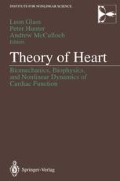Abstract
I present an overview of cable theory for propagation in onedimensional excitable cables and some modifications necessary to account for the discrete cellular nature of myocardial cells and gap junctions. The modified cable theory is shown to agree quite well with a number of recent experiments on propagation in anisotropic tissue that are unexplained by the classical continuous theory.
Access this chapter
Tax calculation will be finalised at checkout
Purchases are for personal use only
Preview
Unable to display preview. Download preview PDF.
References
D.G. Aronson and H.F. Weinberger. Nonlinear diffusion in population genetics, combustion and nerve pulse propagation. In J.A. Goldstein, editor, Proceedings of the Tulane Program on Partial Differential Equations and Related Topics, pages 5–49, Springer-Verlag, Berlin, 1975.
C.W. Balke, M.D. Lesh, J.F. Spear, A. Kadish, J.H. Levine, and E.N. Moore. Effects of cellular uncoupling on conduction in anisotropic canine ventricular myocardium. Circ. Res., 63: 879–892, 1988.
G.W. Beeler and H. Reuter. Reconstruction of the action potential of myocardial fibres. J. Physiol. (Lond.), 268: 177–210, 1977.
L. Clerc. Directional differences of impulse spread in trabecular muscle from mammalian heart. J. Physiol (Lond.), 255: 335–346, 1976.
W.C. Cole, J.B. Picone, and N. Sperelakis. Gap junction uncoupling and discontinuous propagation in the heart. Biophys. J., 53: 809–818, 1988.
C. Delgado, B. Steinhaus, M. Delmar, D.R. Chialvo, and J. Jalife. Directional differences in excitability and margin of safety for propagation in sheep ventricular epicardial muscle. Circ. Res., 67: 97–110, 1990.
M. Delmar, D.C. Michaels, T. Johnson, and J. Jalife. Effects of increasing intercellular resistance on transverse and longitudinal propagation in sheep epicardial muscle. Circ. Res., 60: 780–785, 1987.
P.J. Diaz, Y. Rudy, and R. Plonsey. Intercalated discs as a cause for discontinuous propagation in cardiac muscle: A theoretical simulation. Ann. Biomed. Eng., 11: 177–189, 1983.
D. DiFrancesco and D. Noble. A model of cardiac electrical activity incorporating ionic pumps and concentration changes. Phil. Trans. Roy. Soc. Lond. B., 222: 353–398, 1985.
J.-P. Drouhard and F.A. Roberge. Revised formulation of the Hodgkin-Huxley representation of the sodium current in cardiac cells. Comp. Biomed. Res., 20: 333–350, 1987.
L. Ebihara and E.A. Johnson. Fast sodium current in cardiac muscle, a quantitative description. Biophys. J., 32: 779–790, 1980.
P.C. Fife. Mathematical Aspects of Reacting and Diffusing Systems. Lecture Notes in Biomathematics, vol. 28, Springer-Verlag, Berlin, 1979.
A.L. Hodgkin and A.F. Huxley. A quantitative description of membrane current and its application to conduction and excitation in nerve. J. Physiol., 177: 500–544, 1952.
R.H. Hoyt, M.L. Cohen, and J.E. Saffitz. Distribution and three-dimensional structure of intercellular junctions in canine myocardium. Circ. Res., 64(3): 563–574, 1989.
J.R. Hume and W. Giles. Active and passive electrical properties of single atrial cells. J. Gen. Physiol, 78: 19–42, 1981.
P.F. Hunter, P.A. McNaughton, and D. Noble. Analytical models of propagation in excitable cells. Progr. Biophys. Mol. Biol., 30: 99–144, 1975.
R.W. Joyner. Effects of the discrete pattern of electrical coupling on propagation through an electrical syncytium. Circ. Res., 50: 192–200, 1982.
M. Kawato, A. Yamanaka, S. Urushiba, O. Nagata, H. Irisawa, and R. Suzuki. Simulation analysis of excitation conduction in the heart: Propagation of excitation in different tissues. J. Theor. Biol., 120: 389–409, 1986.
J.P. Keener. On the formation of circulating patterns of excitation in anisotropic excitable media. J. Math. Biol., 26: 41–56, 1988.
J.P. Keener. Propagation and its failure in coupled systems of discrete excitable cells. SIAM J. Appl. Math., 47: 556–572, 1987.
J.M. Kootsey and J. Wu. Anisotropic 2-D model of electrical propagation in cardiac muscle. IEEE/EMBS: 1988.
R.E. McAllister, D. Noble, and R.W. Tsien. Reconstruction of the electrical activity of cardiac Purkinje fibers. J. Physiol., 251: 1–59, 1975.
M.H. Protter and H.F. Weinberger. Maximum Principles in Differential Equations. Prentice-Hall, Englewood Cliffs, N.J., 1967.
F.A. Roberge, A. Vinet, and B. Victorri. Reconstruction of propagated electrical activity with a two-dimensional model of anisotropic heart muscle. Circ. Res., 58: 461–475, 1986.
Y. Rudy and W.-L. Quan. A model study of the effects of the discrete cellular structure on electrical propagation on cardiac tissue. Circ. Res., 61: 815–823, 1987.
M.S. Spach and J.M. Kootsey. The nature of electrical propagation in cardiac muscle. Am. J. Physiol., 244: H3-H22, 1983.
M.S. Spach, W.T. Miller, D.B. Geselowitz, R.C. Barr, J.M. Kootsey, and E.A. Johnson. The discontinuous nature of propagation in normal canine cardiac muscle. Circ. Res., 48: 39–54, 1981.
M.S. Spach and P.C. Dolber. Relating extracellular potentials and their derivatives to anisotropic propagation at the microscopic level in human cardiac muscle: Evidence for uncoupling of side-side fiber connections with increasing age. Circ. Res., 58: 356–371, 1986.
S. Wiedmann. Electrical constants of trabecular muscle on mammalian heart. J. Physiol. (Lond.), 118: 348–360, 1970.
A.L. Wit, S. Dillon, and P.C. Ursell. Influences of anisotropic tissue structure on reentrant ventricular tachycardia. In P. Brugada and H.J. Wellens, editors, Cardiac Arrhythmias: Where to go from here?, pages 27–37, Futura Publishing Co, Mount Kisco, NY, 1987.
J.W. Woodbury and W.E. Crill. The potential in the gap between two abutting cardiac cells. Biophys. J., 10: 1076–1085, 1970.
K. Yanagihara, A. Noma, and H. Irisawa. Reconstruction of sinoatrial node pacemaker potential based on the voltage clamp experiments. Jap. J. Physiol., 30: 841–857, 1980.
B. Zinner. Traveling Wavefront Solutions for the Discrete Nagumo Equation. Ph.D. thesis, University of Utah, 1988.
Author information
Authors and Affiliations
Editor information
Editors and Affiliations
Rights and permissions
Copyright information
© 1991 Springer-Verlag New York, Inc.
About this chapter
Cite this chapter
Keener, J.P. (1991). Wave Propagation in Myocardium. In: Glass, L., Hunter, P., McCulloch, A. (eds) Theory of Heart. Institute for Nonlinear Science. Springer, New York, NY. https://doi.org/10.1007/978-1-4612-3118-9_17
Download citation
DOI: https://doi.org/10.1007/978-1-4612-3118-9_17
Publisher Name: Springer, New York, NY
Print ISBN: 978-1-4612-7803-0
Online ISBN: 978-1-4612-3118-9
eBook Packages: Springer Book Archive

